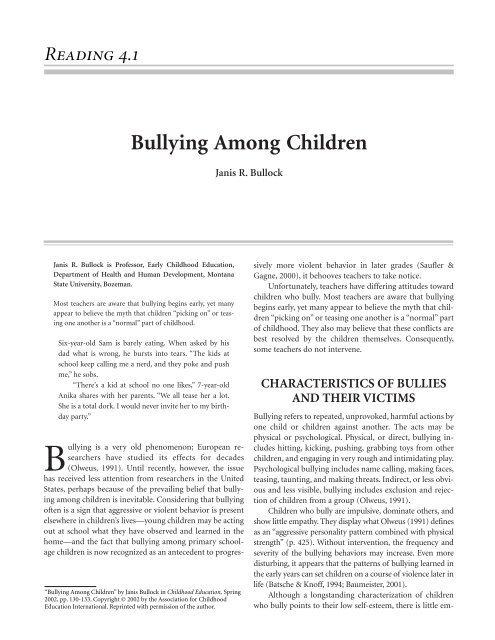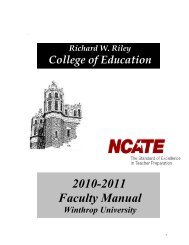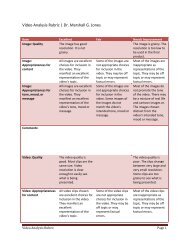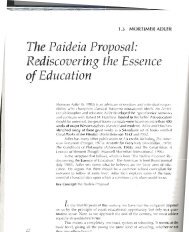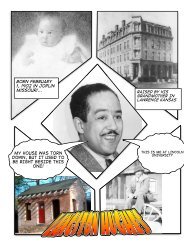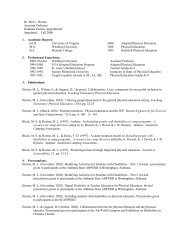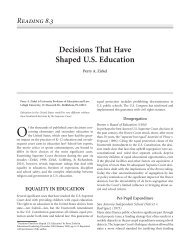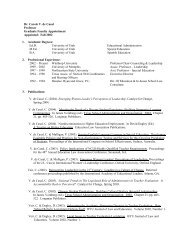incidences of bullying among children - PAWS
incidences of bullying among children - PAWS
incidences of bullying among children - PAWS
You also want an ePaper? Increase the reach of your titles
YUMPU automatically turns print PDFs into web optimized ePapers that Google loves.
Reading 4.1<br />
Bullying Among Children<br />
Janis R. Bullock is Pr<strong>of</strong>essor, Early Childhood Education,<br />
Department <strong>of</strong> Health and Human Development, Montana<br />
State University, Bozeman.<br />
Most teachers are aware that <strong>bullying</strong> begins early, yet many<br />
appear to believe the myth that <strong>children</strong> “picking on” or teasing<br />
one another is a “normal” part <strong>of</strong> childhood.<br />
Six-year-old Sam is barely eating. When asked by his<br />
dad what is wrong, he bursts into tears. “The kids at<br />
school keep calling me a nerd, and they poke and push<br />
me,” he sobs.<br />
“There’s a kid at school no one likes,” 7-year-old<br />
Anika shares with her parents. “We all tease her a lot.<br />
She is a total dork. I would never invite her to my birthday<br />
party.”<br />
Bullying is a very old phenomenon; European researchers<br />
have studied its effects for decades<br />
(Olweus, 1991). Until recently, however, the issue<br />
has received less attention from researchers in the United<br />
States, perhaps because <strong>of</strong> the prevailing belief that <strong>bullying</strong><br />
<strong>among</strong> <strong>children</strong> is inevitable. Considering that <strong>bullying</strong><br />
<strong>of</strong>ten is a sign that aggressive or violent behavior is present<br />
elsewhere in <strong>children</strong>’s lives—young <strong>children</strong> may be acting<br />
out at school what they have observed and learned in the<br />
home—and the fact that <strong>bullying</strong> <strong>among</strong> primary schoolage<br />
<strong>children</strong> is now recognized as an antecedent to progres-<br />
“Bullying Among Children” by Janis Bullock in Childhood Education, Spring<br />
2002, pp. 130-133. Copyright © 2002 by the Association for Childhood<br />
Education International. Reprinted with permission <strong>of</strong> the author.<br />
Janis R. Bullock<br />
sively more violent behavior in later grades (Saufler &<br />
Gagne, 2000), it behooves teachers to take notice.<br />
Unfortunately, teachers have differing attitudes toward<br />
<strong>children</strong> who bully. Most teachers are aware that <strong>bullying</strong><br />
begins early, yet many appear to believe the myth that <strong>children</strong><br />
“picking on” or teasing one another is a “normal” part<br />
<strong>of</strong> childhood. They also may believe that these conflicts are<br />
best resolved by the <strong>children</strong> themselves. Consequently,<br />
some teachers do not intervene.<br />
CHARACTERISTICS OF BULLIES<br />
AND THEIR VICTIMS<br />
Bullying refers to repeated, unprovoked, harmful actions by<br />
one child or <strong>children</strong> against another. The acts may be<br />
physical or psychological. Physical, or direct, <strong>bullying</strong> includes<br />
hitting, kicking, pushing, grabbing toys from other<br />
<strong>children</strong>, and engaging in very rough and intimidating play.<br />
Psychological <strong>bullying</strong> includes name calling, making faces,<br />
teasing, taunting, and making threats. Indirect, or less obvious<br />
and less visible, <strong>bullying</strong> includes exclusion and rejection<br />
<strong>of</strong> <strong>children</strong> from a group (Olweus, 1991).<br />
Children who bully are impulsive, dominate others, and<br />
show little empathy. They display what Olweus (1991) defines<br />
as an “aggressive personality pattern combined with physical<br />
strength” (p. 425). Without intervention, the frequency and<br />
severity <strong>of</strong> the <strong>bullying</strong> behaviors may increase. Even more<br />
disturbing, it appears that the patterns <strong>of</strong> <strong>bullying</strong> learned in<br />
the early years can set <strong>children</strong> on a course <strong>of</strong> violence later in<br />
life (Batsche & Kn<strong>of</strong>f, 1994; Baumeister, 2001).<br />
Although a longstanding characterization <strong>of</strong> <strong>children</strong><br />
who bully points to their low self-esteem, there is little em-
2 THE TEACHERS, SCHOOLS, AND SOCIETY READER<br />
pirical evidence to support this view. In fact, more recent research<br />
(Baumeister, 2001; Bushman & Baumeister, 1998)<br />
suggests that an inflated self-esteem increases the odds <strong>of</strong><br />
aggressive behavior. When a bully’s self-regard is seriously<br />
threatened by insults or criticisms, for example, his or her<br />
response will be more aggressive than normal. Furthermore,<br />
bullies <strong>of</strong>ten report that they feel powerful and superior, and<br />
justified in their actions.<br />
Research on family dynamics suggests that many <strong>children</strong><br />
already have learned to bully others by preschool age.<br />
Many young <strong>children</strong> who bully lack empathy and problem-solving<br />
skills, and learn from their parents to hit back<br />
in response to problems (Loeber & Dishion, 1984; Vladimir<br />
& Brubach, 2000).<br />
Children who are bullied, on the other hand, are<br />
<strong>of</strong>ten younger, weaker, and more passive than the bully.<br />
They appear anxious, insecure, cautious, sensitive and<br />
quiet, and <strong>of</strong>ten react by crying and withdrawing. They<br />
are <strong>of</strong>ten lonely and lack close friendships at school.<br />
Without adult intervention, these <strong>children</strong> are likely to be<br />
bullied repeatedly, putting them at-risk for continued social<br />
rejection, depression, and impaired self-esteem<br />
(Schwartz, Dodge, & Coie, 1994). A smaller subset <strong>of</strong><br />
these <strong>children</strong>, known as “provocative victims,” have<br />
learned to respond aggressively to perceived threats by<br />
retaliating not only against the aggressor, but also against<br />
others (Olweus, 1993).<br />
INCIDENCES OF BULLYING<br />
AMONG CHILDREN<br />
Evidence suggests that, in the United States, the incidence<br />
<strong>of</strong> <strong>bullying</strong> <strong>among</strong> <strong>children</strong> is increasing and becoming a<br />
nationwide problem. One out <strong>of</strong> five <strong>children</strong> admits to<br />
being a bully (Noll & Carter, 1997). In general, boys engage<br />
in more physical, direct means <strong>of</strong> <strong>bullying</strong>, whereas girls<br />
engage in the more psychological and indirect <strong>bullying</strong>,<br />
such as exclusion. Roland (1989) reported that girls may be<br />
involved in <strong>bullying</strong> as much as boys, but are less willing to<br />
acknowledge their involvement. In addition, because indirect<br />
<strong>bullying</strong> is <strong>of</strong>ten less apparent, girls’ <strong>bullying</strong> may be<br />
underestimated. Girls tend to bully less as they get older.<br />
The percentage <strong>of</strong> boys who bully, however, is similar at different<br />
age levels (Smith & Sharp, 1994).<br />
Twenty-five to 50 percent <strong>of</strong> <strong>children</strong> report being bullied.<br />
The great majority <strong>of</strong> boys are bullied by other boys,<br />
while 60 percent <strong>of</strong> girls report being bullied by boys. Eight<br />
percent <strong>of</strong> <strong>children</strong> report staying away from school one<br />
day per month because they fear being bullied. Forty-three<br />
percent <strong>of</strong> <strong>children</strong> have a fear <strong>of</strong> being harassed in the<br />
school bathroom (Noll & Carter, 1997). Children report<br />
that many incidents <strong>of</strong> <strong>bullying</strong> occur in situations that are<br />
difficult for the teacher to monitor, such as during playground<br />
activity.<br />
THE EFFECTS OF BULLYING<br />
ON CHILDREN<br />
To succeed in school, <strong>children</strong> must perceive their environment<br />
as being safe, secure, and comfortable. Yet, for<br />
many <strong>children</strong>, <strong>bullying</strong> and teasing begins as soon as<br />
<strong>children</strong> first form peer groups. For some <strong>children</strong>, this is<br />
a time when patterns <strong>of</strong> victimizing and victimization become<br />
established. Consequently, the victims perceive<br />
school as a threatening place and experience adjustment<br />
difficulties, feelings <strong>of</strong> loneliness, and a desire to avoid<br />
school. These feelings may linger even when <strong>bullying</strong><br />
ceases (Kochenderfer & Ladd, 1996).<br />
Children desire and need interaction with peers, physical<br />
activity, and time outdoors. Consequently, they <strong>of</strong>ten<br />
consider outside recess to be their favorite part <strong>of</strong> the<br />
school day. Sadly, however, many <strong>children</strong> who are bullied<br />
report that problems occur on the playground and view the<br />
playground as a lonely, unhappy, and unsafe environment.<br />
If <strong>children</strong> are fearful or feel intimidated, they cannot<br />
learn effectively. They may react by skipping school, avoiding<br />
certain areas <strong>of</strong> the school (the bathroom or the playground),<br />
or, in extreme, yet increasingly common, cases, they<br />
may bring weapons to school (Noll & Carter, 1997). Olweus<br />
(1991) reminds us that “every individual should have the<br />
right to be spared oppression and repeated, intentional humiliation<br />
in school, as in society at large” (p. 427). As early<br />
exposure to <strong>bullying</strong> can produce both immediate and delayed<br />
effects in <strong>children</strong>’s ability to adjust to school, school<br />
staff need to intervene as soon as problems are detected.<br />
RECOMMENDATIONS FOR<br />
TEACHERS TO SUPPORT<br />
CHILDREN<br />
A comprehensive plan to address the problems <strong>of</strong> <strong>bullying</strong><br />
and teasing must involve school personnel, teachers, <strong>children</strong>,<br />
and families. Intervention must occur on three levels:<br />
school-wide, in specific classrooms, and with individuals.<br />
School-wide Intervention<br />
School personnel must recognize the pervasiveness <strong>of</strong> <strong>bullying</strong><br />
and teasing and its detrimental effects on <strong>children</strong>’s development.<br />
Inservice training can be developed that<br />
outlines a clear policy statement against <strong>bullying</strong> and intervention<br />
strategies for addressing it. The school also can de-
READING 4.1: BULLYING AMONG CHILDREN 3<br />
velop a comprehensive plan geared to teach <strong>children</strong> prosocial<br />
behaviors and skills. The <strong>children</strong> may be involved in<br />
the development <strong>of</strong> such policies and strategies, providing<br />
their input on what behavior is appropriate and identifying<br />
sanctions against bullies (Lickona, 2000; Olweus, 1997).<br />
School personnel could enlist families’ support and involvement<br />
by sharing details <strong>of</strong> the policy through par-entteacher<br />
conferences and newsletters. Families need to be<br />
aware <strong>of</strong> the specific sanctions that will be imposed on <strong>children</strong><br />
who bully, and they need opportunities to <strong>of</strong>fer feedback<br />
and suggestions. It is important to encourage parents<br />
to talk with their <strong>children</strong> about <strong>bullying</strong>. Children who are<br />
bullied <strong>of</strong>ten believe that their parents are unaware <strong>of</strong> the<br />
situation, and that their concerns are not being addressed<br />
or discussed. Children do want adults to intervene, however<br />
(Gropper & Froschl, 1999). If families are kept informed,<br />
they can work as a “team member” with school counselors<br />
and teachers to change the school environment.<br />
Additional sources <strong>of</strong> school-wide support for <strong>children</strong><br />
who are bullied and teased may be developed, including mentoring<br />
programs. Teachers can identify <strong>children</strong> who need<br />
support, and find them a mentor. Children may feel more at<br />
ease and less anxious when they have a “buddy,” such as an<br />
older student, who can help intervene (Noll & Carter, 1997).<br />
Counselors at one elementary school selected, trained, and<br />
supervised high school students to teach the younger <strong>children</strong><br />
how to deal with <strong>bullying</strong> and harassment. After implementation<br />
<strong>of</strong> this program, the teachers observed a decline in reports<br />
<strong>of</strong> harassment (Frieman & Frieman, 2000).<br />
Bullying frequently occurs on the playground<br />
(Whitney, Rivers, Smith, & Sharp, 1994), yet many <strong>children</strong><br />
believe that teachers do little to stop it. Consequently,<br />
“play-time...is more <strong>of</strong> a prison sentence than an opportunity<br />
to play and socialize” (Slee, 1995, p. 326). Therefore,<br />
school personnel may need to review playground design<br />
and space, <strong>children</strong>’s access to these spaces, teacher supervision,<br />
and the role <strong>of</strong> the school in early intervention on the<br />
playground (Lambert, 1999). Yard monitors and lunch<br />
time supervisors can be trained to watch for signs <strong>of</strong> <strong>bullying</strong>.<br />
In addition, <strong>children</strong> can be asked to identify those<br />
places where <strong>bullying</strong> most frequently occurs.<br />
INTERVENTION IN SPECIFIC<br />
CLASSROOMS<br />
Clearly, <strong>bullying</strong> and hurtful teasing affects <strong>children</strong>’s ability<br />
to learn and enjoy play, as well as the teacher’s ability to<br />
teach. Within the classroom, teachers can begin addressing<br />
the problem by creating times for <strong>children</strong> to talk about<br />
their concerns. Interestingly, one study showed that when<br />
<strong>children</strong> ages 5 to 7 years <strong>of</strong> age were asked about assisting<br />
someone who was being bullied, 37 percent replied that it<br />
was none <strong>of</strong> their business to help (Slee & Rigby, 1994).<br />
Teachers can ask <strong>children</strong> to talk about what makes<br />
them feel unsafe or unwelcome in school. The teacher then<br />
can make a list <strong>of</strong> the <strong>children</strong>’s responses, discuss them<br />
(e.g., “I don’t like it when someone hits me or calls me a<br />
name”), and create corresponding rules (e.g., “Hitting and<br />
name calling are not allowed in the classroom”). When necessary,<br />
the discussions can be continued during class meetings<br />
so that the rules can be reviewed, revised, and updated.<br />
The teacher can also show <strong>children</strong> what to do to help<br />
themselves or other <strong>children</strong>, and remind them <strong>of</strong> the consequences<br />
<strong>of</strong> breaking the rules. Teachers can reduce <strong>children</strong>’s<br />
anxiety by setting firm limits on unacceptable<br />
behavior (Froschl & Sprung, 1999).<br />
If the <strong>bullying</strong> continues, teachers may need to make<br />
referrals to school counselors who will work with <strong>children</strong>,<br />
either individually or in groups, to talk about concerns, discuss<br />
solutions and options, and give suggestions on how to<br />
form friendships. Children without close friends are more<br />
likely to be victimized and may benefit from specific suggestions<br />
for building friendships (e.g., invite a friend to<br />
your house, work together on a school project, share a<br />
common interest, play a favorite game together).<br />
Certain types <strong>of</strong> curricula, especially those that provide<br />
opportunities for cooperative learning experiences, may<br />
make <strong>bullying</strong> less likely to flourish. Children need to be<br />
engaged in worthwhile, authentic learning activities that<br />
encourage their interests and abilities (Katz, 1993). When<br />
they are intellectually motivated, they are less likely to<br />
bully. For example, project work (Katz & Chard, 2000) involves<br />
<strong>children</strong>’s in-depth investigations into topics <strong>of</strong> their<br />
own choosing. As they explore events and objects around<br />
them in the classroom, in the school yard, in the neighborhood,<br />
and in the community, they learn to cooperate, collaborate,<br />
and share responsibilities. Project work can be<br />
complemented by noncompetitive games, role playing, and<br />
dramatization to raise awareness <strong>of</strong> <strong>bullying</strong> and increase<br />
empathy for those who experience it. Some teachers use<br />
<strong>children</strong>’s literature to help create caring and peaceful classrooms<br />
(Morris, Taylor, & Wilson, 2000).<br />
INTERVENTION WITH<br />
INDIVIDUALS<br />
Developing both immediate and long-term strategies for<br />
identifying and working with bullies may be necessary.<br />
When teachers observe an incident <strong>of</strong> <strong>bullying</strong>, they can intervene<br />
by asking the bully to consider the consequences <strong>of</strong><br />
his or her actions and think about how others feel. By talking<br />
calmly, yet firmly, to the bully, the teacher can make it
4 THE TEACHERS, SCHOOLS, AND SOCIETY READER<br />
clear that such behavior is unacceptable. Teachers can show<br />
the bully alternate ways to talk, interact, and negotiate; at<br />
the same time, they can encourage victims to assert themselves.<br />
By doing so, the teacher is showing the bully and the<br />
victim that action is being taken to stop the <strong>bullying</strong>.<br />
Acting promptly can prevent the <strong>bullying</strong> from escalating.<br />
When interacting with <strong>children</strong> on a one-on-one basis,<br />
teachers should provide encouragement that acknowledges<br />
specific attributes, rather than dispensing general praise, approval,<br />
or admiration (“I am so glad that you have done a<br />
great job; it is wonderful; yours is one <strong>of</strong> the best projects”)<br />
that may appear to be contrived. Expressions <strong>of</strong> specific encouragement<br />
(“You seem to be pleased and very interested<br />
in your project, and it appears you have worked on it for<br />
many days and used many resources to find answers to your<br />
questions”), as opposed to general praise, are descriptive,<br />
sincere, take place in private, focus on the process, and help<br />
<strong>children</strong> to develop an appreciation for their efforts and<br />
work. While developing <strong>children</strong>’s self-esteem is a worthwhile<br />
goal, false praise may instead promote narcissism and<br />
unrealistic self-regard. Teachers should avoid encouraging<br />
<strong>children</strong> to think highly <strong>of</strong> themselves when they have not<br />
earned it (Baumeister, 2001; Hitz & Driscoll, 1988).<br />
Additional long-term strategies may include encouraging<br />
<strong>children</strong> to resolve their own problems and using peers<br />
to mediate between bullies and their targets. Furthermore,<br />
teachers can spend time helping <strong>children</strong> to form ties with<br />
peers who can <strong>of</strong>fer protection, support, security, and<br />
safety, thus helping to reduce <strong>children</strong>’s exposure to <strong>bullying</strong><br />
(Kochenderfer & Ladd, 1997; Ladd, Kochenderfer, &<br />
Coleman, 1996).<br />
SUMMARY<br />
Bullying and teasing are an unfortunate part <strong>of</strong> too many<br />
<strong>children</strong>’s lives, leading to trouble for both bullies and their<br />
victims. Children who are bullied come to believe that<br />
school is unsafe and that <strong>children</strong> are mean. They may develop<br />
low self-esteem and experience loneliness. Children<br />
who continue to bully will have difficulty developing and<br />
maintaining positive relationships. A comprehensive intervention<br />
plan that addresses the needs <strong>of</strong> the school, the<br />
classroom, teachers, <strong>children</strong>, and families can be developed<br />
and implemented to ensure that all <strong>children</strong> learn in a<br />
supportive and safe environment.<br />
REFERENCES<br />
Batsche, G. M., & Kn<strong>of</strong>f, H. M. (1994). Bullies and their victims:<br />
Understanding a pervasive problem in the<br />
schools. School Psychology Review, 23, 165–174.<br />
Baumeister, R. (2001). Violent pride: Do people turn violent<br />
because <strong>of</strong> self-hate, or self-love? Scientific<br />
American, 284, 96–101.<br />
Bushman, B. J., & Baumeister, R. F. (1998). Threatened egotism,<br />
narcissism, self-esteem, and direct and displaced<br />
aggression: Does self-love or self-hate lead to violence?<br />
Journal <strong>of</strong> Personality and Social Psychology, 75, 219–229.<br />
Frieman, M., & Frieman, B. B. (2000). Reducing harassment<br />
in elementary school classrooms using high school mentors.<br />
(ERIC Document Reproduction Service No. ED<br />
439 797).<br />
Froschl, M., & Sprung, B. (1999). On purpose: Addressing<br />
teasing and <strong>bullying</strong> in early childhood. Young<br />
Children, 54, 70–72. Gropper, N., & Froschl, M. (1999).<br />
The role <strong>of</strong> gender in young <strong>children</strong>’s teasing and <strong>bullying</strong><br />
behavior. Montreal, Canada. (ERIC Document<br />
Reproduction Service No. ED 431 162). Hitz, R., &<br />
Driscoll, A. (1988). Praise or encouragement? New insights<br />
into praise: Implications for early childhood<br />
teachers. Young Children, 42, 6–13. Katz, L. G. (1993).<br />
Distinctions between self-esteem and narcissism:<br />
Implications for practice. Urbana, IL: ERIC<br />
Clearinghouse on Elementary and Early Childhood<br />
Education. Katz, L., & Chard, S. (2000). Engaging <strong>children</strong>’s<br />
minds: The project approach (2nd ed.). Stamford,<br />
CT: Ablex. Kochenderfer, B. J., & Ladd, G. W. (1996).<br />
Peer victimization: Cause or consequence <strong>of</strong> school<br />
maladjustment? Child Development, 67, 1305–1317.<br />
Kochenderfer, B. J., & Ladd, G. W. (1997). Victimized<br />
<strong>children</strong>’s responses to peers’ aggression: Behaviors associated<br />
with reduced versus continued victimization.<br />
Development and Psychopathology, 9, 59–73.<br />
Ladd, G. W., Kochenderfer, B. J., & Coleman, C. (1996).<br />
Friendship quality as a predictor <strong>of</strong> young <strong>children</strong>’s<br />
early school adjustment. Child Development, 67,<br />
1103–1118.<br />
Lambert, E. B. (1999). Do school playgrounds trigger playground<br />
<strong>bullying</strong>? Canadian Children, 42, 25–31.<br />
Lickona, T. (2000). Sticks and stones may break my bones<br />
AND names WILL hurt me. Thirteen ways to prevent<br />
peer cruelty. Our Children, 26, 12–14.<br />
Loeber, R., & Dishion, T. J. (1984). Boys who fight at home<br />
and school: Family conditions influencing cross-setting<br />
consistency. Journal <strong>of</strong> Consulting and Clinical<br />
Psychology, 52, 759–768.<br />
Morris, V. G., Taylor, S. I., & Wilson, J. T. (2000). Using <strong>children</strong>’s<br />
stories to promote peace in classrooms. Early<br />
Childhood Education Journal, 28, 41–50.<br />
Noll, K., & Carter, J. (1997). Taking the bully by the horns.<br />
Reading, PA: Unicorn Press.<br />
Olweus, D. (1991). Bully/victim problems <strong>among</strong> school<strong>children</strong>:<br />
Basic facts and effects <strong>of</strong> a school based intervention<br />
program. In D. J. Pepler & K. H. Rubin (Eds.),
READING 4.1: BULLYING AMONG CHILDREN 5<br />
The development and treatment <strong>of</strong> childhood aggression<br />
(pp. 441–448). Hillsdale, NJ: Lawrence Erlbaum.<br />
Olweus, D. (1993). Victimization by peers: Antecedents and<br />
long-term outcomes. In K. H. Rubin & J. B. Asendorf<br />
(Eds.), Social withdrawal, inhibition, and shyness in<br />
childhood (pp. 315–341). Hillsdale, NJ: Lawrence<br />
Erlbaum.<br />
Olweus, D. (1997). Bully/victim problems in school: Facts<br />
and intervention. European Journal <strong>of</strong> Psychology <strong>of</strong><br />
Education, 12, 495–510.<br />
Roland, E. (1989). Bullying: The Scandinavian research tradition.<br />
In D. P. Tattum & D. A. Lane (Eds.), Bullying in<br />
schools (pp. 21–32). London: Trentham Books.<br />
Saufler, C., & Gagne, C. (2000). Maine project against <strong>bullying</strong>.<br />
Final report. Augusta, ME: Maine State Department<br />
<strong>of</strong> Education. (ERIC Document Reproduction Service<br />
No. ED 447 911).<br />
Schwartz, D., Dodge, K. A., & Coie, J. D. (1994). The emergence<br />
<strong>of</strong> chronic peer victimization in boys’ play<br />
groups. Child Development, 64, 1755–1772.<br />
Slee, P.T. (1995). Bullying in the playground: The impact <strong>of</strong><br />
interpersonal violence on Australian <strong>children</strong>’s perceptions<br />
<strong>of</strong> their play environment. Children’s Environments,<br />
12, 320–327.<br />
Slee, P. T., & Rigby, K. (1994). Peer victimisation at school.<br />
AECA Australian Journal <strong>of</strong> Early Education, 19, 3–10.<br />
Smith, P. K., & Sharp, S. (1994). The problem <strong>of</strong> school <strong>bullying</strong>.<br />
In P. K. Smith & S. Sharp (Eds.), School <strong>bullying</strong><br />
(pp. 1–19). London: Routledge.<br />
Vladimir, N., & Brubach, A. (2000). Teasing <strong>among</strong> schoolaged<br />
<strong>children</strong>. (ERIC Document Reproduction Service<br />
No. 446 321).<br />
Whitney, I., Rivers, I., Smith, P. K., & Sharp, S. (1994). The<br />
Sheffield project: Methodology and findings. In P. K.<br />
Smith & S. Sharp (Eds.), School <strong>bullying</strong> (pp. 20–56).<br />
London: Routledge.


